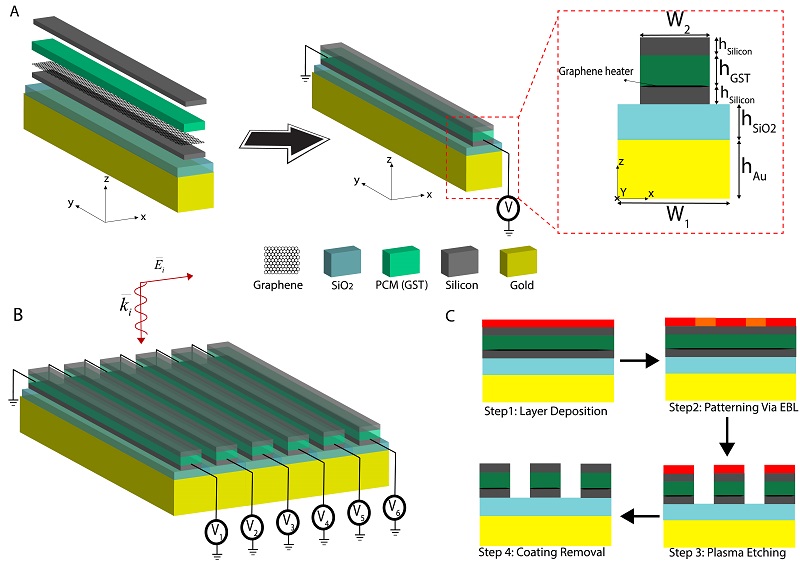Mr. Pooria Salami successfully defended his Ph.D. thesis titled “Sub-Wavelength Imaging using Optical Hyperbolic Metamaterials”.
Author Archives: Omid
Our paper on “Optical Tunable Metasurfaces” was accepted for publication in Optics Express!
Abstract:
Tunable metasurfaces enable us to dynamically control light at subwavelength scales. Here, using phase change materials and transparent graphene heaters, a new structure is proposed to develop tunable metasurfaces which support first-order Mie-type resonance in the near-IR regime. In the proposed structure, by adjusting the bias voltages applied to transparent graphene heaters, the crystallization levels of the phase change materials are controlled, which in turn modifies the response of the metasurface. The proposed metasurface is able to modulate the phase of the reflected wave in the range of 0° to −270° at the telecommunication wavelength of λ = 1.55 µm. A comprehensive Joule heating analysis is performed to investigate the thermal characterizations of the proposed structure. The results of this analysis show that there is a suitable thermal isolation between adjacent unit cells, making individual control on unit cells possible. The potential ability of the proposed metasurface as a beam steering device is also demonstrated. By using the proposed unit cells, a beam-steering device is designed and numerically studied. This study shows that the device can reflect a light normally incident on it in the range of ±65° with reasonably low sidelobe levels. The proposed structure can be used in developing low-cost integrated LiDARs.

Link:
https://www.osapublishing.org/oe/fulltext.cfm?uri=oe-28-23-33876&id=441947
Mr. Hadi Mohajerani successfully defended his master’s thesis, Congrats to Hadi!
Mr. Hadi Mohajerani successfully defended his Master’s thesis titled “Absorption Enhancement in Solar Cells using Traveling Wave Nano-Antennas” with excellent grade.
Welcome to our new group members, Mr. Zahedi and Mr. Zirak.
Mr. Mohmmad Reza Safaeian successfully defended his master’s thesis, Congrats to Reza!
Mr. Mohmmad Reza Safaeian successfully defended his Master’s thesis titled “Design, Optimization, and Analysis of a Beam Steering Based Bio-Sensor” with excellent grade.
Mr. Omid Abed successfully defended his master’s thesis, Congrats to Omid!
Mr. Omid Abed successfully defended his Master’s thesis titled “Realization of Optical Beam Steering for integrated Lidars” with excellent grade.
Dr. Yousefi was elevated to Associate Professor.
Dr. Yousefi was elevated to the grade of IEEE Senior Member.
Our paper on “ Solar Antennas : SOLANTs” was accepted for publication in IEEE Journal on Emerging and Selected Topics in Circuits and Systems.
Abstract:
A fast analytical method for calculating the radiation pattern of solar antennas (SOLANTs) consisting of metasurface-based solar cells is proposed. The proposed method is able to analyse both uniform and non-uniform metasurfaces. In the developed method, the reciprocity theorem along with the transmission line model is used to model the layered structure used in the design of SOLANTs. To model the printed antenna, the cavity model is modified to include the loading effect of solar cells on the antenna. The proposed method is used to analyse three different SOLANTs operating at different frequency regimes, and the results are verified through comparison with full wave numerical results. The proposed model can be used for optimization purposes with the goal of achieving the best possible configurations for SOLANT structures.


Link:
Our team won the challenge of “Brain Stimulation”.
Our team won the challenge of “Brain Stimulation”.
Congrats to Pooria Salami, Hamid Akbari, and Ali Eghrari!